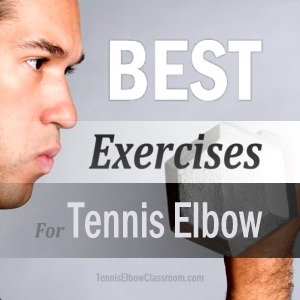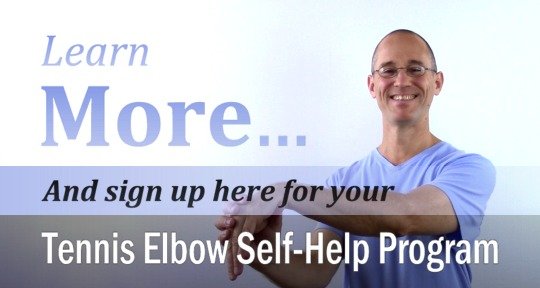To make a full, lasting recovery from your Tennis Elbow or Golfer’s Elbow, you’ll need a set of rehab exercises that target the specific muscles and tendons involved in your injury…
This article and video covers the three best Tennis Elbow exercises, which ones to start with, and why the “indirect approach” is the best way to begin your rehab – (rather than just doing them all at once!)
And here’s an overview of the principles of Tennis Elbow rehab exercise
Podcast Episode Version On The Best Exercises
Here’s an improved, better-sounding version of the podcast that you can download and keep by clicking the “download” link under the player below:
The 3 Key Exercises For The “Tennis Elbow Muscle”
The three main exercises that work the main muscle involved in your injury are:
- Wrist Deviation – (The “hammering” motion)
- Wrist Supination – (The “door-knob-opening” motion)
- And Wrist Extension – (The “ringing-out-wet-towel” motion or the direction of opening your hand if your wrist follows your fingers backwards)
Some Tennis Elbow sufferers may be able to begin their strengthening program with all three…
But the safest way to begin is with just one or two, (when you’re at the right point in your healing process, of course)

What Are The Best Tennis Elbow Exercises?
So, the idea is, rather than targeting the injured muscles and tendons directly, (at first) it’s much safer to start out with exercises that work indirectly.
The first two exercises, deviation and supination (the hammering and doorknob-opening motions) involve the main Tennis Elbow muscle group, but in a synergistic or “complimentary” way.
In other words, your injured muscle is not taking on the full burden and doing all the work by itself – It’s working in tandem, sharing the load with other muscles, which is a safer way to begin.
Pure wrist extension requires the full participation of your Tennis Elbow muscle, (Extensor Carpi Radialis Brevis) since wrist extension is that muscle’s main job.
Whereas, in wrist deviation (that’s the hammering motion) and in supination (which is the doorknob-opening motion) your Tennis Elbow muscle plays a supportive role.
Wrist deviation involves both your Tennis Elbow muscle AND it’s opposite (Flexor Carpi Radialis) in 50/50 partnership, which I think is a great way to start.
And supination involves your supinator muscle and your bicep primarily, as your Tennis Elbow muscle plays a supportive, “back-seat” role doing less than half the work.
The Safest Exercise To Begin Strengthening With
I recommend starting with wrist deviation and then adding supination, and eventually including wrist extension.
And possibly beginning the exercises in an “eccentric-only” fashion – which I cover separately here:
Article and video on eccentric exercise
I think Deviation, (the hammering motion) is the best, first choice starting exercise for several reasons:
- It’s a simple motion,
- It’s usually the least painful,
- It’s hard to do wrong,
- AND it’s easy to do eccentrically!
Be careful with supination though… (that’s the door-knob-opening motion – or we could call it the windshield-wiper motion)…
If you’re not cautious you can easily go too far in your range of motion and place too much stress on your tendons especially as you start reversing direction.
Of course, if you only do the eccentric part when you’re starting your strengthening program this is not really a concern.
And once you’re making progress with deviation and supination…
Once you can tell you’re getting stronger and the exercises haven’t aggravated your Tennis Elbow – (or they don’t cause pain or aggravate it very much any longer – If they did at first)…
THEN you can start including wrist extension – possibly doing only the eccentric part of the motion at first, though.
(It’s also a very good idea to work the muscles on the opposite side of your forearm and wrist that perform the opposing motions: Wrist deviation in the opposite direction, pronation and wrist flexion.)
See also this article: “What are the goals of rehab exercise?”
Naturally, there are right ways and wrong ways to do these exercises.
For example, in several photos and videos I’ve seen the wrist deviation exercise demonstrated with a hammer or dowel where the elbow is fully extended (straightened) and the arm held out in front of the person at shoulder level.
This is a bad idea because it unnecessarily places more strain on the shoulder AND the elbow. It’s a somewhat unnatural position to hold and there’s no need to hold it.
A better way to do it is with your arm at your side with your elbow bent at 90 degrees – just like the position you ideally type on a keyboard OR with your arm slightly in front of your body and your elbow a little straighter than 90 degrees.
And last but not least, there’s a very important question to ask:
When Should You Start The Rehab Process?
At what point in your treatment and healing process should you begin your rehab exercises? Here’s the short answer, but check out the following article for more detail:
Article on the question of rehab exercise timing
In my experience, therapy should be first, followed by stretching and then exercise later on, once the healing process is well under way.
That’s not an absolute rule, by any means – It depends on how serious your injury is.
Some Tennis Elbow sufferers can start therapy, stretching and exercising all at once (not that I’d recommend it, but it does work for some with milder injuries)
But those with moderate to severe, chronic injuries may need to do the therapy part first, for some time, before attempting any exercises.
And when I say therapy, what I mean is direct, hands-on manipulation of the muscles and tendons (I hesitate to call it massage, because that’s too general a term for this)
And that’s the most important thing I teach members here in “The Classroom!”
What about Physical Therapy or Physiotherapy? you may be wondering.
See that article and video for the details, but the short answer is that although you will most certainly be given rehab exercises to do in a PT clinic…
The vast majority of Physical Therapists – (at least here in the US – especially in a managed care situation) – do not perform any hands on / Massage / Manual Therapy.
And I strongly believe that’s the missing link is in treating this stubborn injury and breaking its vicious cycle of tension, degeneration and pain.
So, I invite you to learn the best self-treatment “massage” techniques from a real Neuromuscular Therapist who treats Tennis Elbow every day.
I’m standing by ready to be your tutor! Check out the programs for both Tennis and Golfer’s Elbow – Links below:
Learn To Treat And Heal Your Own Tennis Elbow Or Golfer’s Elbow At Home With This Video Program
You’ll get instant access to a complete VIDEO program designed by a professional therapist to help you take charge and break your vicious cycle of pain and frustration!…I’ll be your personal tutor guiding you through step-by-step video lessons, where you’ll get the therapy techniques, key stretches and essential exercises you need to treat and recover from your injury at home. (Without any special equipment.)
Just watch the videos, follow along and start putting an end to your elbow pain today, whether you have Golfer’s or Tennis Elbow from playing your guitar – or other stringed instrument or ANY instrument, for that matter!)
Tennis Elbow sufferers: Learn More About The Tennis Elbow Program Here
Golfer’s Elbow sufferers: Learn More About The Golfer’s Elbow Program Here
What about working out, in general? Here’s an article on the question of “Can you can still work out?”
And, if you do keep working out, here’s one on the exercises you should probably avoid!







Hi Allen,
my tennis elbow is on both elbows!!!!! a real nuisance, I have rested for a couple of weeks now but they are still sore, all due to bad form methinks from heavy barbell rows (wrists sagging) and loading up my forearms and wrist extensors. I have some resistance bands and along with the first hammer type rehab exercise you have described which I will start slowly with can I use the bands to keep up my training ( very light of course) a few times a week. The upper body exercises i thought I would do are: Chest Press with neutral grip
Rows with neutral grip
Shoulder press with neutral grip
as you can tell I still want to exercise as am near 50 years of age and with a fair amount of cardio I do I still want to maintain some strength and muscle so don’t want to stop completely. A great site and your advice would be much appreciated as I am a great advocate of active rest when injured.
kind regards
Daryl
Hi Allen
i would like to get your program but do you offer flex pays? I am on a budget and is it ok to exercise when i have sharp pain going through my arm feel like a needle the top part of my arm i been going to physical therapy it been 3 months now feel like i have no energy left should i avoid the rolling ball on my arm that physical therapy does on my arm? it hurt like hell. i do follow physical therapy exercise bottom line should i avoid the rolling ball altogether need advice thanks i got tennis elbow on the outside over use from,computer
Hi Julia, I’m sorry I don’t have any kind of flex pay. Generally it’s NOT a good idea to exercise if you feel sharp pain while exercising. I’m not sure about your ball question. I can’t advise you on that.
Hello Allen
For sure, that’s the best website the is for getting knowledge about tennis elbow. Find this website was like to reach some oasis in the middle of the desert. I would like to thank you very much.
My question is: these exercises can be aplied to both tennis and golfer’s elbow, or it serves only for tennis elbow?
Thank you, João! I tend to believe that exercises are much less of a priority for Golfer’s Elbow. I believe the VAST majority of effort should be on releasing the wrist and finger flexors from all their adhesions, tension and shortening.